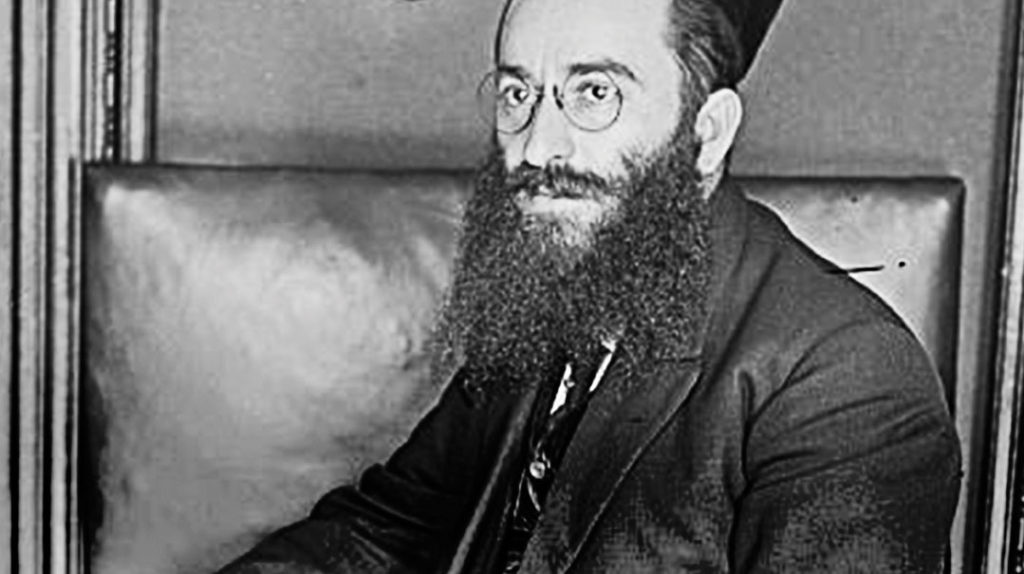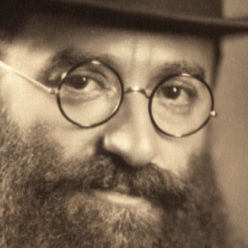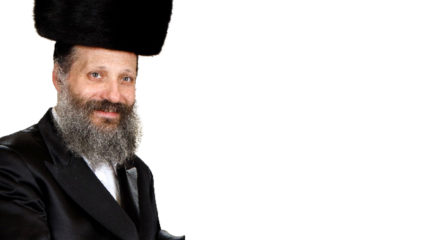Yossele Rosenblatt's music has stood the test of time and continues to bring the legacy of a great chazzan and a gutte Yid to a new generation
For so many, the Yamim Noraim davening means experiencing an annual uplift with the traditional chazzanus and nusach of yesteryear. In honor of Rosh Hashanah 5781, Endnote celebrates the unparalleled contribution of Cantor Yossele Rosenblatt to the world of nusach hatefillah. He passed away in 1933 at only 51 years of age, but in those short years, the “king of cantors” bequeathed us over 600 compositions, some of which are part of every shul’s Rosh Hashanah davening. It wasn’t just his musical genius, his rich, clear tenor, or his exceptional mastery and range that made Yossele Rosenblatt stand out — it was the soul he poured out in prayer and passed along. He was the first to put chazzanus to vinyl, and his recordings for various phonograph companies were influential in spreading his fame (as a G-d-fearing Torah Jew, he turned down many inappropriate lucrative offers from the wider music world) and preserving his creations.
A repertoire of Yossele’s compositions is part of every cantor’s performance portfolio, but it is not only professionals who can sing and enjoy these melodies. Songs like the classic “Hamavdil” and “A Seudenyu” are accessible to any baal tefillah, choir, or layman and are full of warmth and energy. Yossele’s music has stood the test of time and continues to bring the legacy of a great chazzan and a gutte Yid to a new generation.
Our Panelists
CHAZZAN YAAKOV MOTZEN
Chazzan Motzen is the fifth generation in a family of cantors, and has been leading davening and performing for 52 years. Born in Tel Aviv and a former talmid in Kol Torah, Beer Yaakov and Ponevezh, Motzen has held cantorial positions in Montreal and Toronto, and for the lasr 14 years, has been chazzan of The Shul in Bal Harbour, Florida. He currently resides in Englewood, New Jersey, but travels around the world to perform.
CHAZZAN MOTTI BOYER
Jerusalem-born Chazzan Boyer, 30, is an Eretz Yisrael-based acclaimed chazzan who comes from a family of baalei tefillah. He began studying music at age seven, and is today considered an expert on Rosenblatt’s compositions, a Yossele-impressionist, and is a composer of chazzanus and chassidic niggunim. He leads Yom Tov davening in shuls in Eretz Yisrael, the US, and Europe.
MENDY WERDYGER
Mendy Werdyger, singer, songwriter, and owner and director of the Aderet music label and its retail store, Mostly Music, is the son of Chazzan Dovid Werdyger a”h, brother of MBD, and father of singer Yisroel Werdyger. For the past 30 years, he’s been the Yamin Noraim baal tefillah at the Gerrer shtibel in Boro Park. As an expert on restoration of old records, he has, together with his son Mayer, re-mastered the recordings of Yossele Rosenblatt, producing his eight-volume “Od Yosef Chai” series which has brought Yossele’s music back to life for a new generation.
The most widely popular Rosenblatt piece today
Mendy Werdyger
The one piece every chazzan in every shul still uses today is “Hineni He’ani Mimaas.” Another very popular piece is “Racheim Nah,” which I think was the first Yossele piece I ever heard.
Motti Boyer
The most widespread Rosenblatt song, which is played at every simchah before bentshing and which some people just peg as a traditional tune, is Yossele’s “Shir Hamaalos.”
Yaakov Motzen
The interesting thing is that everyone, those who love chazzanus and those who hate it, chassidim, Litvaks and secular, knows what is generally assumed to be Rosenblatt’s niggun for “Shir Hamaalos,” but it wasn’t actually his composition. It was, in fact, composed by a chazzan named Pinny Minkowsky, but Yossele was the first to record it and popularize the niggun through the world. I even have the original manuscript of Yossele’s musical notation for it.
My Favorite Yom Tov Piece
Motti Boyer
I love them all — each piece is a perfect work of art, as well as work of heart. There are really two types of Yossele pieces: niggunim (melodies) and recitative pieces, which are like musical declamation (as used in the narrative parts of an opera, l’havdil). Yossele’s chiddush was that he turned the recitative parts, which the chazzan traditionally just recited, into a type of melody. An example of this is his “Kevakoras Ro’eh Edro,” which brings the words to life in a recitative niggun. If you listen carefully to “Hineni He’ani Mimaas,” for example, which is probably sung by every Ashkenazi baal tefillah around the world, you can feel how special it is because the nusach gives expression to the meaning of the words.
Mendy Werdyger
I use a lot of Yossele’s nusach pieces when I daven from the amud. “Teka Beshofar Gadol” is a personal favorite. It has so many different motifs and really brings out and expresses the mood of the words.
Yaakov Motzen
Are you going to ask me who my favorite child is, too? There are so many that it’s too hard to name just one. That said, when I’m accompanied by a choir, for Hallel I like to sing Yossele’s “Hashem Zecharanu” and “Mekimi Me’afar Dal.”
A Chazzan’s Favorite Pick
Motti Boyer
Every chazzan has his own taste, but for most, the true favorites are the pieces that speak to the audience. I think “Brich Shemei,” “Racheim Nah,” and “Elokai” will be sung forever.
Mendy Werdyger
It’s really a matter of taste. Everyone incorporates the pieces they like into their own style of davening.
Yaakov Motzen
Yossele was tremendously versatile, so there is no single style for his pieces. You can find something different in every piece. He himself was a tenor, but he had incredible range. A chazzan has to know his ability and his limitations — not everyone can sing every piece, because of the range and the coloratura. My signature Yossele piece is “Acheinu,” which I’ve performed many times in concert. It expresses those moving words so perfectly.
The song that’s most difficult to sing correctly
Yaakov Motzen
I’d say, “Teka Beshofar Gadol,” a difficult piece that I sing in shul sometimes, but I won’t perform in concert, due to the length of the coloratura and the complexity of the breathing it entails. It is a piece where you can hear the peirush hamilim, because the sound of the shofar is in the tune. There’s also “Ad Heinah,” which has more classical operatic influence and a difficult range.
Mendy Werdyger
“Habeit,” my favorite, is a very complicated piece.
Motti Boyer
You need a tremendous vocal range and dynamic transitions to sing “Amar Rabi Elazar” or “Ad Heinah” correctly.
Yossele Rosenblatt As A Person, Not Just A Voice
Mendy Werdyger
He was a yarei Shamayim, which was not a given among chazzanim of his time. Rosenblatt’s compositions are not just pretty tunes, but express the words of the tefillah. He was a chassid of the Chortkover Rebbe and came to America in 1912, when it was a spiritual and religious midbar. People were not interested in Yiddishkeit, and he swam against the tide, remaining a ben Torah, setting aside time to learn every day. Cleofonte Campanini, director of the Chicago Opera House, offered him a fortune for a show, but Yossele turned it down because of shemiras Shabbos and other religious considerations. That’s probably why his music has endured.
Yaakov Motzen
I knew his son and his grandson, and I can tell you, everyone agrees that Yossele was a very nice guy. He lost a lot of money when two partners took advantage of him, offering him the chance to invest in a new Jewish newspaper in New York, but it was a scam. You can see his feinkeit and temimus in his davening.
Motti Boyer
Yossele was a chassid of Chortkov and Ruzhin. He was a great Jew and very generous. Even when he lost all his savings due to fraud by a partner with whom he had invested, he continued to appear gratis for charities. Because of his religious principles, he refused to sing for the opera, which would have been a way out of his financial difficulties, creating a great kiddush Hashem.
What we know about Yossele’s compositions and recordings
Yaakov Motzen
There are about 600 Rosenblatt melodies that we know of, and there were more, too. His ability to compose was unusual, as most of the great chazzanim could not compose — their skill was in the singing. Yossele’s music has many influences, all Jewish. He came from Galicia, then spent time in Munkacs, and was appointed chazzan in Pressburg (where my own grandfather actually succeeded him as chazzan) at the beginning of the 1900s, before he came to America to accept the position of chazzan of Congregation Ohab Tzedek in Manhattan. The nusach prevalent in those places definitely influenced his compositions, and then there are the lighter pieces, too.
Mendy Werdyger
It was a different era of recording — back then, albums were four minutes per side. Some of Rosenblatt’s songs were composed according to the length of the side, while for others, like “Acheinu,” you had to turn over the record because the second half was on the other side. “Bameh Madlikin,” which Rosenblatt left over in note form, was never recorded because of its length — it takes about half an hour to sing.
One Truly Uplifting Piece
Mendy Werdyger
I find that Yossele’s singing in general is a great introduction to the Rosh Hashanah spirit. I listen to it to bring me into the right frame of mind for Elul. There is a piece called “Habeit Mishamayim” which is not very well known, but musically, it is just so warm, uplifting, and deep. For a Gemara comparison, you could say it’s like a Tosafos.
Motti Boyer
The less well-known “Omar Rabi Elazar” — Yossele actually composed two melodies for these words, and it’s the second composition that became more widely-known. But the first one has an unusual level of inspiration. The tune has something of the melody of Torah-learning. Listening to Yossele singing has a uniquely experiential quality, and can transport you to another place, another mood, with the beauty of his song. When I sing this piece, I can almost feel him there with me. His “Yismechu Bemalchuscha” also has that experiential effect — you sense that feeling of malchus while you listen to it.
Yossele’s Trademark “Head Voice,” Or “Kop Shtimme”
Yaakov Motzen
Kop shtimme is often confused with falsetto, but they are two different things. Falsetto is produced in the chest, while kop shtimmer comes from the head, and is actually known by some voice teachers as “head voice.” The vocal chords are very delicate, and in certain positions of the larynx, the voice can go very high, and mastery of this trick is part of Yossele’s claim to fame, used in every second or third piece. I am sure that chazzanim did it before him, but recordings were not in existence, so we don’t really know.
The kop shtimme serves to make a piece of music more interesting, with that element of surprise and excitement. There are some chazzanim and composers who very much prefer the high notes. Yes, high notes are the most beautiful, but let’s be honest — how much chocolate can you eat in one go? You need to keep the high notes for the end, so that you are not giving it too early. I am a fan of other chazzanim, also — too many names to mention — but Yossele is the king because he had everything that a chazzan should have.
Motti Boyer
It’s a kind of vocal craftsmanship, a form of high art. Yossele didn’t lack for vocal range, but the kop shtimme takes the voice to another level of the art of chazzanus. It sounds almost like a flute cadenza, and typically appears just before the end of a piece.
Mendy Werdyger
There are two well-known types of tools that chazzanim use. One is kop shtimme, which changes the mood, both for variation and so that they are not pushing and straining the vocal chords, and the other is coloratura — the elaborate ornamentation of vocal melodies. Yossele was a master of both. That’s why he set a new standard in chazzanus.
Those never-fail crowd pleasers
Mendy Werdyger
I think people like the Yamim Noraim pieces with which they are most familiar. But don’t forget that Yossele is also famous for some Yiddish songs, like the popular “Mein Yiddishe Mamme,” and the traditional lullaby, “Shluff Zisser Ruh.” I’m not sure that he was the original composer or if he took previously existing Yiddish verses and set them to music, but he popularized them.
Yaakov Motzen
Well, you have to know your audience. Older people, war survivors, and those who lost relatives in Israel’s wars tend to relate to the more emotional pieces, where they can be moved and cry along with the chazzan. The younger generation, a couple of generations away from the Holocaust, generally prefer more classical chazzanus. But the question will soon be whether the audience even knows Yossele’s music or enjoys it at all.
I have no problem with more modern music. I even sing Carlebach niggunim myself sometimes when I daven, but I do get upset when people have no idea of the traditional nusach. It is in danger of getting lost. For example, Rabbi Hillel Paley composed a beautiful tune for Ochilah La’keil, but the traditional nusach for it is from the Maharil. Let’s not lose it.
Motti Boyer
An experienced chazzan knows that you can’t sing every single shtickel. However much the crowd likes chazzanus, how many hours can they stay in shul on Shabbos morning? But Yossele’s second “Amar Rabi Elazar” is very well-liked. I’ve noticed when I daven in New York that people remain until the very end of davening because they want to hear “Amar Rabi Elazar,” and they will even remind the chazzan that they want him to sing it. Some say it on Friday night after the “Bameh Madlikin” section, but the most common place to sing it is at the end of Mussaf. Another very popular piece is “Brich Shemei,” a composition of Yossele’s which was only publicized after his passing.
Yossele’s Best Shabbos Niggunim
Mendy Werdyger
The Rosh Chodesh bentshing is beautiful. Actually, I think it’s Yossele’s most recorded piece. He recorded it in Hamburg, and then, since it was so popular, he re-recorded it a few times once he was in the States. There were few record labels around at the time, and Yossele worked with several, including RCA Records. Legend has it that Thomas Edison himself recorded him once. In those days, the studios kept a metal master copy of every recording they did. When World War I broke out, there was such a severe shortage of metal that those master copies were melted down, and that’s why it is so difficult to find originals of Yossele. Yossele fans and collectors have plenty of work cut out for them.
Motti Boyer
I particularly like to sing “Hashem Malach,” “Zoreia Tzedakos,” “Yishtabach,” a very warm nusach piece, and Yossele’s “Zarah Chayah,” from the Yekum Purkan tefillah. The “Zarah Chayah” is not easy to sing because there is a lot of coloratura — listen out for the word ‘ravrevayah’! — but that is the true art of chazzanus.
Yaakov Motzen
There is a beautiful composition for the tefillah we say when taking out the Sefer Torah: “Ana Avda.” I often sing that, and if I feel that the crowd won’t appreciate the chazzanus, I just sing the refrain.
My Favorite Yossele Rosenblatt Story
Motti Boyer
I was once with my late father visiting Rav Chaim Brim ztz”l, and Rav Chaim told us that when Rosenblatt visited Yerushalayim, he was once chased by kano’im. They had noticed that when he davened, he would occasionally hold on to something by his ear, and they thought it was a tuning fork, which is forbidden on Shabbos. But actually, it was a tiny bottle of water to wet his hands with, in case he touched his peyos.
Mendy Werdyger
On a visit back to Europe, Yossele went to visit Rebbe Bentzion, the Kedushas Tzion of Bobov. The Rebbe sent someone out to tell people that “a big chazzan is here from America, and he will be giving out five zlotys to everyone in town.” The crowd gathered, and Yossele sang his “Elokai Neshamah,” offering the townspeople a free concert worth five zlotys.
Another time, a meshulach from Eretz Yisrael arrived late at night to stay with Yossele in New York and asked where he could find a minyan for Maariv. Yossele went into the hallway of his apartment block and started to sing a cantorial Maariv. Everyone came out to hear it, and there was his minyan.
Yaakov Motzen
Of course, the most famous story was when he turned down the offer from the Chicago Opera. He needed the money desperately but would not compromise his principles. That was the mark of a quality person, who would never sell his Yiddishkeit for money. Rosenblatt was known far beyond the Jewish world, in the operatic world, and he met a lot of singers when he sang on the radio, but he remained a real chassidishe Yid.
Special thanks to Rabbi Menachem Fordsham for the concept and for his assistance with this piece.
(Originally featured in Mishpacha, Issue 828)




